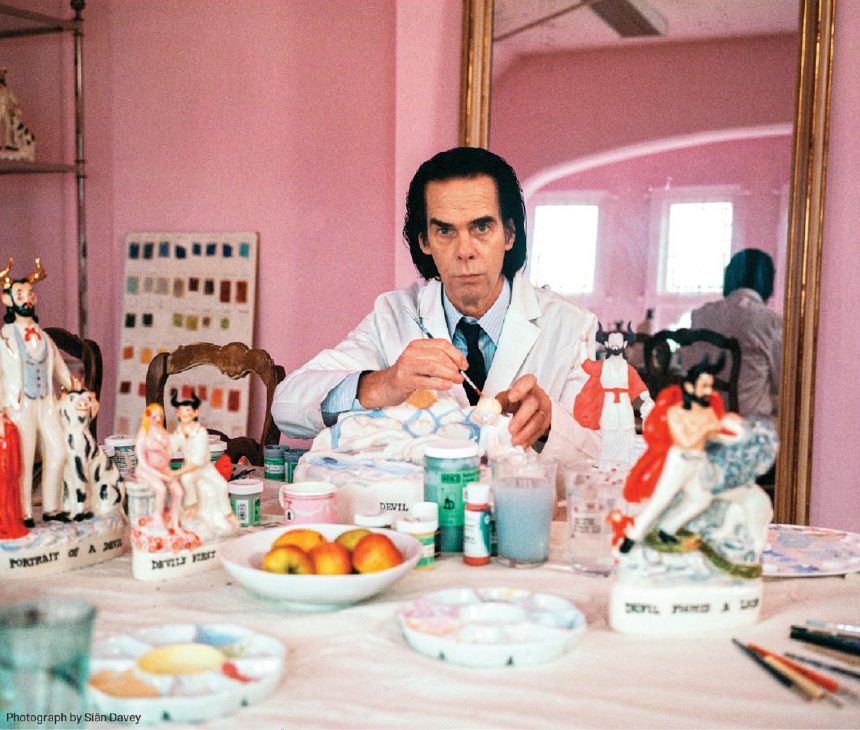At Voorlinden, Nick Cave (1957) has his first solo museum exhibition with his series The Devil – A Life. The Australian artist is primarily known as a musician but studied visual art in his earlier years. In this series, Cave narrates the life of the devil, from his birth to his death, through seventeen hand-painted ceramic figures. Museum Voorlinden has acquired the entire series.
14 December 2024 - 16 March 2025
Artist Talk
Margriet van der Linden interviewed Nick Cave at Voorlinden:
Video: Studio Roodenburch
Flatback figurines
Nick Cave’s The Devil – A Life (2020-24) is a series of glazed ceramic figurines depicting the life of the Devil in 17 stations, from innocence through experience into confrontation of our mortality. Nick Cave was inspired by Staffordshire flatback figurines, which became popular mantelpiece decorations in the Victorian period. The series is Cave’s first major body of visual work, culminating in his first solo museum exhibition.
What started as a desire to create a single small devil figure as a vehicle for an intense red glaze became a journey towards some kind of absolution from a series of shattering events. — Nick Cave

Nick Cave, Devil as Child, Portait of a Devil, Devil’s Last Dance, 2020-2024
Collection museum Voorlinden, photos: Courtesy the Artist and Xavier Hufkens, Brussels
Flawed Figure
The Devil — A Life is a visual narrative that explores the complexities of the human condition. Rather than depicting a fearsome Antichrist, Cave portrays the Devil as a flawed, relatable figure, illustrating the blend of good and bad inherent in everyone. Through his experience of the vicissitudes of life in a very human way, he becomes a symbol of humanity’s darker, irrational sides, while also embodying our shared desire to be and do better. The story’s trajectory is inspired by the Stations of the Cross, a series of fourteen images depicting Jesus Christ on the day of his crucifixion. In his series, Cave shows how the Devil evolves with the passage of time, accompanied by symbolic figurines like a blood-red monkey and red, black and white horses —the colours of the three steeds ridden by the horsemen of the Apocalypse from the Book of Revelation.
Staffordshire flatbacks are traditionally mass-produced figurines made for the mantelpiece. In Nick Cave’s hands, however, they become art. This deeply personal series of sculptures shows, in powerful colours and compositions, the story of the devil as an everyday man, shaped by triumph, grief and remorse. – Suzanne Swarts, director Voorlinden

Artist Book Nick Cave
Want to delve deeper in the story of the Devil? Nick Cave has collaborated with Voorlinden on an artist book that tells the story of The Devil – A Life. The beautifully crafted book includes images of all the Devil-figurines and a story written by Cave. The artist book serves as a poetic extension of the visual narrative of the ceramic series and is available in the museumshop.

Nick Cave, Devil in Remorse, 2020-2024
Collection museum Voorlinden, photos: Courtesy the Artist and Xavier Hufkens, Brussels
About Nick Cave
Nick Cave is a singer, songwriter, poet, lyricist, author, screenwriter and composer. He was born in Warracknabeal in Victoria, Australia and studied painting at the Caulfield Institute of Technology in Melbourne before abandoning his studies to pursue music. He rose to prominence fronting The Birthday Party (1973-83) before forming his current band, Nick Cave and The Bad Seeds, in 1984. Religion is a recurring theme in his work, which he approaches with a mixture of both doubt and belief. This tension is reflected in and essential for his creative process, as he draws on religion to inspire deeper and more imaginative ways of thinking. The Devil — A Life (2020-24) was previously shown at Xavier Hufkens Gallery in Brussels, Belgium, and was part of the exhibition We at the Sara Hildén Art Museum in Finland, together with work by Thomas Houseago and Brad Pitt.

Photo: Sian Davey, courtesy of the Michael Hoppen Gallery
At night, when I try to sleep, I close my eyes and see the figurines parading by in sequence — the newborn Devil nestled against the foal, the infant with his ball of fire, the child holding the red monkey, the Devil seducing the girl, the Devil riding off to war through a field of flowers, and then returning on a black horse down a road of skulls, on and on they go, the Devil with his bride and the golden rabbit, the Devil sacrificing the child on the altar, the Devil separated from the world, on and on, the Devil sitting on a wall, his tears pooling around his feet, his chilling, operatic death, and at last his body washed up on a beach, a child crouched by his side reaching out a hand in forgiveness. This procession makes a certain sense and brings me enormous comfort. It draws my own story out of the darkness, out of the chaos, to stand in testament to something. It brings an order to the world and a kind of peace. — Nick Cave
